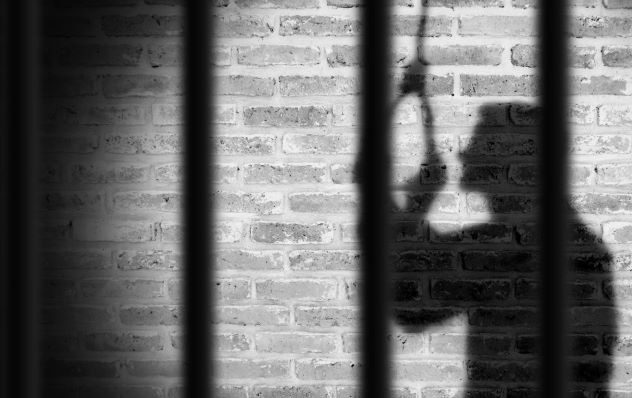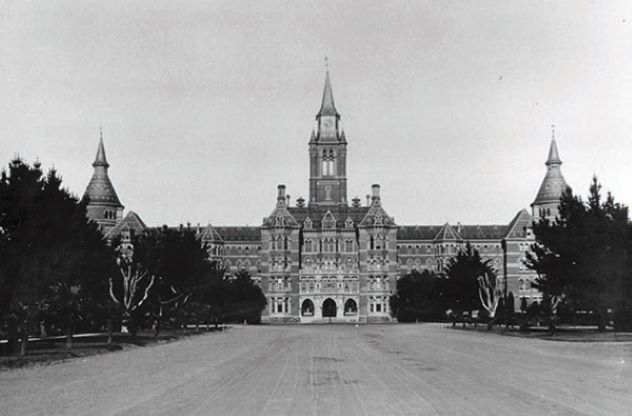 Crime
Crime  Crime
Crime  Technology
Technology 10 Hilariously Over-Engineered Solutions to Simple Problems
 Miscellaneous
Miscellaneous 10 Ironic News Stories Straight out of an Alanis Morissette Song
 Politics
Politics 10 Lesser-Known Far-Right Groups of the 21st Century
 History
History Ten Revealing Facts about Daily Domestic Life in the Old West
 Weird Stuff
Weird Stuff 10 Everyday Products Surprisingly Made by Inmates
 Movies and TV
Movies and TV 10 Actors Dragged out of Retirement for One Key Role
 Creepy
Creepy 10 Lesser-Known Shapeshifter Legends from Around the World
 Animals
Animals 10 Amazing Animal Tales from the Ancient World
 Gaming
Gaming 10 Game Characters Everyone Hated Playing
 Crime
Crime 10 Terrifying Serial Killers from Centuries Ago
 Technology
Technology 10 Hilariously Over-Engineered Solutions to Simple Problems
 Miscellaneous
Miscellaneous 10 Ironic News Stories Straight out of an Alanis Morissette Song
Who's Behind Listverse?

Jamie Frater
Head Editor
Jamie founded Listverse due to an insatiable desire to share fascinating, obscure, and bizarre facts. He has been a guest speaker on numerous national radio and television stations and is a five time published author.
More About Us Politics
Politics 10 Lesser-Known Far-Right Groups of the 21st Century
 History
History Ten Revealing Facts about Daily Domestic Life in the Old West
 Weird Stuff
Weird Stuff 10 Everyday Products Surprisingly Made by Inmates
 Movies and TV
Movies and TV 10 Actors Dragged out of Retirement for One Key Role
 Creepy
Creepy 10 Lesser-Known Shapeshifter Legends from Around the World
 Animals
Animals 10 Amazing Animal Tales from the Ancient World
 Gaming
Gaming 10 Game Characters Everyone Hated Playing
Ten True Tales from America’s Toughest Prison
The death penalty has been a controversial aspect of American history for centuries. With it, California’s San Quentin State Prison has been the country’s most well-known death row for many years. The first execution of a prisoner took place in the prison way back in 1893.
For the next several decades, San Quentin was the site of hundreds of executions. However, California has now reconsidered its stance on the death penalty. By 2023, the state moved to slowly begin transferring its death row inmates housed at San Quentin to other facilities. Change may yet come for the notorious prison.
But that hasn’t stopped San Quentin’s reputation from continuing to spread. The prison is known as one of the country’s toughest, most violent, and most restrictive jails. Johnny Cash infamously performed there once in 1969, forever making San Quentin a part of outlaw lore. Throughout its long history, tales of San Quentin’s most violent offenders have bubbled up into a life of their own.
In this list, you’ll learn all about ten terrifying—and true—tales taken from America’s toughest and most notorious prison.
Related: 10 Serial Killers Who Were Shockingly Released From Prison Early
10 The Inconsistent Gas Chamber
Throughout San Quentin’s history, prison officials have used three methods of execution: hanging, gas, and lethal injection. For a while, San Quentin and nearby Folsom Prison shared hanging duties for California. But by 1938, the notorious prison’s gas chamber became operational. So the warden started sending prisoners to die there. But it didn’t come without major faults.
In fact, prison officials decided to test the gas chamber with a live animal before putting a prisoner inside. So they put a pig in the chamber. Shockingly, it took the animal more than 35 minutes to finally succumb to the gas. Clearly, the chamber had some kinks to work out before executions could begin—to say the very least.
The pig problem was a big one for San Quentin. When the gas chamber’s manufacturer installed the room, they boasted the gas would only take 15 seconds to kill a condemned man. So when the pig took over half an hour to die, California prison officials were alarmed. Warden Court Smith made his doubts known from the very beginning of the chamber’s appearance on the prison grounds. “Hanging is bad enough,” he said of death row, “but this—it’s terrible.” Even so, prison officials wanted to make it right and put it to use. They got their chance soon after the chamber was first installed too.
A prison riot at Folsom left four men dead, including the warden. The perpetrators were sent to San Quentin to die by gas. And that they did. Spectators were traumatized to see it happen. And the men who died knew it was bad from the very start. Albert Kessell—the first man to die in San Quentin’s gas chamber—uttered two very memorable words as his statement once inside: “it’s bad.”[1]
9 From Gas to Lethal Injection
For about six decades, the gas chamber was the method of choice on death row. But in 1996, San Quentin officials changed things once again. That year, they ordered those making their final walk to die by lethal injection. The first killer to be executed in this manner at San Quentin was the infamous William Bonin. He was known in his life as the Freeway Killer.
Bonin ended up confessing to the torture of nearly two dozen men and boys he came across on California highways in the 1970s and 1980s. He wreaked havoc on his targets—who were trying to hitchhike across the state—for over a decade. After finding his victims at random, he would kill them in isolated places and dump their bodies until he was finally caught and imprisoned. By the time his death row case came up, he had long since been condemned at San Quentin.
Bonin seemed to revel in the attention he got on death row before his sentence was carried out. He enjoyed pizza and ice cream for his last meal. He even watched Jeopardy the night before he was executed. Protestors and death penalty supporters alike gathered outside the prison as Bonin was led to the gallows. Before the first-ever lethal injection in California could be administered into his arm, he made one final statement.
As the crowd looked on in a mix of shock, fascination, and horror, he said: “They feel that my death will bring closure. But that’s not the case. They’re going to find out.” Maybe they did find out, but Bonin wasn’t around to see it. Moments after making that statement, his sentence was carried out. He became San Quentin’s first-ever prisoner to die by lethal injection after spending 13 years on death row.[2]
8 If You Build It, You Will Come (Back)
By 1990, exactly 501 people had been executed on San Quentin’s death row. Surely, they all had shocking and horrifying stories. But none was more unique than that of Alfred Wells. Wells had been a prisoner on San Quentin’s normal prison block serving time for a burglary charge in the 1930s. During that time, he was ordered to help construct the prison’s gas chamber.
So Wells and a host of other non-condemned inmates installed the chamber on the grounds as part of their work duties. The chamber freaked Wells out, though. While installing it, another inmate remembered him saying, “that’s the closest I ever want to come to the gas chamber.” If only Wells knew what was to come.
After several more years in San Quentin on the burglary rap, Wells was released on parole. When he got back home, he started seeing his half-sister. As you might expect, the Wells family balked at that unsettling romantic relationship. Wells didn’t care for their criticism, though. As the family continued to come after him, his temper rose. One day, he killed his half-brother and two other women over the family feud.
He went on the run, and for a month, cops statewide couldn’t find him. Finally, police tracked him down and arrested him. He was convicted of the murders and sent back to San Quentin. By that point, it was official: he was to be a condemned man. The gas chamber builder who was so scared of the installation suddenly found himself back where he never wanted to be. In 1942, he was killed in the very gas chamber he had helped build less than a decade before.[3]
7 Egan Eager for a Hanging

Dallas Egan lived like many single men did during the Great Depression: by any means necessary. The professional burglar spent his time robbing, stealing, and pilfering to survive and make money. But as the years went on and the Depression got worse, Egan raised the stakes. In 1932, he and his gang robbed a jewelry store. They stole the equivalent of about $100,000 in today’s money.
During the robbery, a 76-year-old man stepped into the store. He had been there innocently to check out a watch. But when Egan saw him, he saw a potential eyewitness to their crime. So he shot the man dead through the store window. With the gang having greatly upped the stakes of their crimes, cops quickly closed in. When Egan was arrested, he admitted to the crime. Soon, he was shipped off to court.
Once he went in front of a judge, Egan didn’t use up much energy to save his own life. The judge intended to ask Egan whether he should remain in society—or, at the very least, have his life spared with a long prison sentence. But Egan was done with society, and he wanted out permanently at San Quentin. “I can think of nothing better than the drop through the gallows,” Egan told the judge about his (lack of) future plans. “I’m a criminal at heart, and I want to be hanged.”
The judge couldn’t find it within him to argue that point. Egan was given a hearty breakfast and allowed to smoke a cigar. Then, he swigged a few shots of whiskey for courage. Prison officials handcuffed him and led him to the gallows. All along the way, he danced with apparent glee. He climbed the steps, was roped into the gallows, and hanged. He never even gave a final statement. Clearly, he was ready to go.[4]
6 Decades on Death Row

In 1978, a 21-year-old woman named Theresa Graybeal was out buying food for her beloved dogs. It should have been a normal errand, but it became a life-changing event in moments. A group of four men carjacked her without warning. They told her they needed to get up the highway to Fresno. They took Graybeal all the way to the central California city. Once they got to the outskirts, they pulled to the side of the road and took her out of the car.
The men then shot her at point-blank range and left her for dead. Cops quickly tracked down the group, but the justice handed out was inconsistent at best. One of the assailants was given just five years for the crime. Another one—who was a minor—was granted immunity in exchange for his testimony. A third person was sentenced to 12 years. And a fourth, identified as Douglas Stankewitz, was convicted of the actual killing and sentenced to death row.
Ever since, Stakenwitz has claimed he is innocent of the crime. He admits to being in the car that night but says he wasn’t the one who carjacked Graybeal or killed her. By 2012, new information on the case seemed to partially side with Stankewitz. An appeals court cut down his sentence to life without parole. He kept living on San Quentin’s death row, though. By then, he had become the prison’s longest-ever living death row resident.
By 2022, he’d been on death row for an astonishing 44 years. During that entire time, he reported in an interview, he only felt grass under his feet just five times. He’s still holding out hope for parole one day. That may not happen, but it’s clear he won’t die at the hands of the state anymore. Still, his life on death row has been a very, very long one. The longest ever, in fact.[5]
5 Death Row Goes Hollywood
Theodore Durrant was a faithful Baptist living in San Francisco in the late 19th century. He served as the assistant Sunday school director for the Emmanuel Baptist Church in town. He was also a student at Cooper Medical College at the time. His access to that church and his medical knowledge would come together in shocking fashion soon enough.
Just before the turn of the century, Durrant murdered two women—Blanche Lamont and Minnie Williams—in two particularly brutal stabbings. Cops investigating the case compared him to Jack the Ripper. The women were found in the church’s belfry. Their bodies had been placed on elevated boxes high in the building. Investigators thought Durrant did so to slow decomposition after their deaths. Cops caught him anyways, though. Soon, he was sentenced to die at San Quentin.
By the time Durrant was sentenced to hang, daily conditions were already notorious on the inside. His alarmed father felt it was worthwhile to expose prison life to the masses. So he hired a camera crew and got special permission from the warden to film inside. The film was meant to highlight Durrant’s supposed sensitive side. The murderer’s father was hoping to drum up public support for his son ahead of his execution. But the film spectacularly backfired.
Unfortunately, it was shown publicly without being carefully edited. At one point in the film, the prison warden’s daughter was shown on camera. The warden was horrified at this breach of privacy and worried for her safety. He ordered the screening over and banned the film from being distributed. Even today, no known copies of the film exist. As for Durrant, the movie dreams didn’t help: He was hanged at San Quentin on January 7, 1898.[6]
4 The Hangman’s Noose Turns on Him

Amos Lunt worked for a long time as the designated hangman at San Quentin. He had a rough life. Before becoming an executioner, Lunt was a veteran of the Civil War. He had also been a police officer on the West Coast. And when San Quentin created the role of Chief Deputy Warden in 1894, he jumped at it.
In the role, Lunt was responsible for overseeing the prison’s executions. Over just the first two years’ time on the job, Lunt oversaw the executions of nearly two dozen men. Finally, by 1899, he was replaced. When incoming deputy warden Frank Arbogast showed up, Lunt warned him of the job. “They are after me,” the outgoing hangman said. “There are several under the bed now… it’s only a matter of time until they get me.”
Prison officials hoped Lunt would have an easier time with regular guard duties. For a little while, it seemed like that might be the case. But soon, the hallucinations kicked in. By 1900, he was seeing things on the job and hearing strange voices. A year later, he was committed to the California State Asylum in Napa.
Tragically, even medical professionals couldn’t keep him from succumbing to his demons. In September of that year, Lunt died in the facility. Newspaper accounts of the time—not recognizing the PTSD and trauma responses we know so well today—wondered whether his time as executioner had curtailed his life well before it was supposed to end.[7]
3 Equal Executions for All
There have only ever been a few women executed at San Quentin. The most well-known of them all was Juanita Spinelli. She was a legendary character in northern California during the Great Depression. In fact, much of her life is a mix of myth and fact that today is impossible to separate. But what we do know is that she was a notorious criminal. She was so successful at robbing, stealing, and plundering that she ran an informal school for other would-be criminals.
Spinelli would teach young thugs how to steal and then bring the most promising ones into her crew. For a long time, they focused only on robbery. But in 1940, her gang shot a man to death. Spinelli was arrested for the crime, convicted, and sent to death row. She went down swinging, though. At her trial, she tried to blame her own daughter for the murder. The court didn’t buy it, and she was sentenced to death.
In 1940, the idea that a woman would be executed was an affront to much of American society. Even other San Quentin inmates didn’t want to see a member of the fairer sex die in jail. They may have been worn down and hardened by difficult living conditions in the notorious prison, but this was a bridge too far. So they petitioned for a stay of execution for Spinelli. Some even volunteered to take her place in the gas chamber. But it wasn’t meant to be.
The state pushed forward with its prosecution against her. Just about a year after her 1940 conviction, Spinelli was executed in San Quentin’s gas chamber. Oh, and about that daughter she unsuccessfully tried to finger for the murder that landed her in jail? Spinelli carried her photo to the gas chamber. It was the last thing she saw as she died.[8]
2 A Terrible Execution Leads to a Pause
Aaron Mitchell was convicted of killing a cop in central California in the 1960s and sent to San Quentin. Like so many other prisoners before him, Mitchell was sent to the gas chamber in April 1967. But what should have been a normal execution that month was anything but. The man’s state-sanctioned killing was so traumatic that California paused executions afterward.
Things were fraught from the start. Mitchell attempted to cut his wrists with a piece of metal he’d smuggled into his cell the day before his scheduled execution. Another prisoner told guards, who rushed in to save him. When asked about it, the eyewitness reported Mitchell had been yelling, “I am the second coming of Jesus,” and “I am the son of God,” as he did it.
That night, guards were able to calm Mitchell in his cell by the gas chamber. Doctors finally stopped the bleeding, and they moved to have him rest. But hours later, Mitchell stripped off his clothes, re-opened his wounds, and began chanting about Jesus Christ once again. The next day, he was marched off to the gas chamber. Guards stood by as he was given a chance to say his final words before the moment of truth. Once again, his last words were, “I am Jesus Christ.”
Psychiatrists who were present there worried he was having a mental break and shouldn’t be executed. The state went through with it, though. Still, uncertainty lingered. California wondered whether Mitchell’s defense at trial had been incompetent and should have portrayed him as mentally ill. It was too late for him, as his death was carried out. But the state paused executions afterward while trying to find a more amenable solution to future justice.[9]
1 Rattlesnake James’s Last Stand
Undoubtedly, Major Raymond Lisemba was one of San Quentin’s strangest death row inmates. He was better known as Robert James when he was in prison there. He was a notorious wife-killer who previously tried—sometimes successfully—to off his brides in exchange for insurance money. The major left a trail of two wives back east that experienced his violent ways and divorced him.
When he moved west, he changed his name to Robert James. Then, he took out an insurance policy on his third wife and tried to kill her in a staged car accident. She survived that but succumbed later when he drowned her in a bathtub. Before authorities could catch onto his scheme, he took a fourth wife. She didn’t sign the life insurance paperwork, though, so he ditched her.
Wife number five was the lucky—or unlucky—one to bring about James’s end. In 1935, James met and married Mary Emma Busch. The two lived together in southern California when he got the urge to commit murder and insurance fraud once more.
James hired the job out to a pal to kill Busch by having her bitten by two rattlesnakes. The bites didn’t do their job, though, and hours later, Busch was still alive. So James did the job himself, drowning her in a bathtub and staging her body in the backyard to make it look like an accident. James’s ill-fated accomplice eventually admitted to the crime, and James was arrested, jailed, and convicted.
That’s when things got really weird. When he landed at San Quentin, James was already known as Rattlesnake James. The notoriety of his crimes had gotten around, and the media and other prisoners wanted to make note of it. Before his sentenced death date in 1942, journalists showed up and asked for publicity photos. They had him pose with a saw to make it look like he was staging an escape.
The macabre photo shoot was James’s last public stand. But he didn’t go down without a fight. When it was time to hang, the executioner used a noose that was several feet too long. Instead of dying instantly, James slowly suffocated while suffering terribly on the gallows. Some considered it a dark (but perfect) ending, seeing how he’d killed wives who trusted him during his sordid life.[10]








